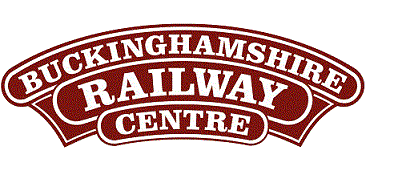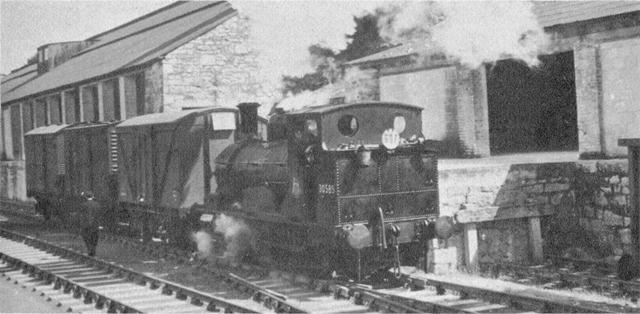
BRC Website Home
Quainton Virtual Stockbook
Rebuilt LSWR 0298 Class 2-4-0 Well Tank No. 0314
Miscellaneous Quainton Publications
The Centenary of the Beattie Well Tank at Quainton

BRC Website Home
Quainton Virtual Stockbook
Rebuilt LSWR 0298 Class 2-4-0 Well Tank No. 0314
Miscellaneous Quainton Publications
The Centenary of the Beattie Well Tank at Quainton
Working at Wadebridge

Photo: |
|
It is of interest to know a little of the railway history of the lines in Cornwall which were the preserves of the Beattie tanks for so many years because in a number of ways this part of the London & South Western Railway was unique. The Bodmin and Wadebridge Railway was one of Britain's earliest true railways and was granted its Act of Incorporation by Parliament in 1832. The reason for its inception was the need to provide transport for sea sand having a high lime content from the coast near Wadebridge to farms in the valley of the River Camel for use as an agricultural fertiliser and to attract traffic in minerals from the many mines and quarries in the districts served down the line to Wadebridge for shipment. The entire system was opened for traffic in 1834 and comprised a main line from Wadebridge up the valley to Wenford Bridge, the direct line to Bodmin and a branch to Ruthern Bridge. The length of the railway from Wadebridge to Bodmin was 6 miles 51 chains. At Grogley, 2 miles 72 chains from Wadebridge, the Ruthern Bridge mineral line made a junction which faced towards Bodmin while at Dunmere, 5 miles 7 chains from Wadebridge, there was a facing junction for the Wenford mineral line. The Ruthern Bridge branch was 1 mile 14½ chains long and the Wenford Bridge line was 6 miles 56 chains long. All the B & W R is open to traffic in 1975 except the Ruthern Bridge branch which was officially closed on 30th December 1933 after almost 100 years of service. The traffic on the Ruthern Bridge branch was originally tin and iron ore from the mines which then existed in the area. In the latter years the traffic was mostly grain, manure and foodstuffs and coal for the district of Withiel. In 1926 the branch was shortened by 6½ chains and the loop at the new terminus was able to accommodate eight wagons. The Beattie tanks were the only engines permitted to work over the branch and our own engine, then 0314, with Driver Cross, worked the last trip over the line on 29th November 1933. The severely curved Wenford Bridge line was always used only for freight and mineral traffic. It climbs the valley of the River Camel from the junction and for nearly two miles the route is through a beautiful avenue of trees. A trip up the branch in the brake van of a train of wagons hauled by one of the Beattie tanks was an unforgettable experience and the situation as described was the position as found by an observer in 1936. 'After leaving Dunmere Junction the shunter held up the road traffic at the ungated siding was waiting to deal with a wagon of grain for Messrs Hawkes's mill which, incidentally adjoined her house. At Penhargard, about two miles from Dunmere, under the archway of trees, the engine stopped to take water from the tank alongside the line; an idyllic setting on a sunny spring day. Helland Siding, one mile past the watering point, also had a woman in charge and at the stone buildings of Messrs Draydon & Son's mill there was a van of feeding stuffs for the local farmer. The next siding, 1¾ miles further on, was for the Road Stone Company's Tresarrett Quarry, but this was out of use after 1933. On the other side of the line was Parkin's (Stump Oak) siding for powdered china clay which had been brought down in fluid form by pipeline from the Greenborough Works, Blisland and settled out and dried in the tanks and furnaces alongside the railway. The next siding, ¼ mile past this point, was called Tresarrett Wharf and served the Bodmin Granite Company and the grain mill of W. Keats & Sons of Blisland. Proceeding up the branch for another mile, the next private siding was owned by English Clays, Lovering and Pochin Ltd. The large settlement tanks for the slurry were glaringly white and these were alongside the railway with the drying furnaces. The clay from the pits at Stanmor Moor, six miles away, was liquified and pumped down to the premises for settling and drying prior to transport by rail. At Wenford Bridge, 11 miles 63 chains from Wadebridge and 266 miles from Waterloo the terminus was reached. Here there was a long loop and sidings, a goods office and a 5 ton gantry crane spanning one track for loading wagons with granite blocks. In 1936 there were two quarries, Messrs Nankivell's and May Bros at St. Breward and there was also an extension of one siding to a cable worked incline serving the De Lank quarries. For sixty years the Ruthern Bridge and Wenford Bridge branches were the exclusive preserves of the three Beattie well tanks and the environment was a far cry from the Victorian bustle of the London suburban services, but it was the same characteristics of flexibility, light weight, short wheelbase and sound construction which made these gallant little locomotives so suited to the dissimilar activities at the eastern and western extremities of the L S W R. Reference: |
|
Notes: |
Text © Quainton Railway Society / Photographs © Quainton Railway Society or referenced photographer
Email Webmaster
Page Updated: 15 October 2017